spyros
Tuberous Breast
What is a tuberous breast
Tuberous Breast
The Tuberous or Tubular Breast is a congenital (from birth) abnormality of the breast shape. There are several theories that try to explain how this condition occurs, but the exact cause is yet unknown.
https://www.keramidasevangelos.com/%CF%86%CF%89%CF%84%CE%BF%CE%B3%CF%81%CE%B1%CF%86%CE%AF%CE%B5%CF%82-%CF%80%CF%81%CE%B9%CE%BD-%CE%BC%CE%B5%CF%84%CE%AC/%CE%B1%CF%83%CF%8D%CE%BC%CE%BC%CE%B5%CF%84%CF%81%CE%BF-%CF%83%CF%84%CE%AE%CE%B8%CE%BF%CF%82/author/31-spyros?start=230#sigProId30da3f832a
Normal Breast
The pictures below show a normal breast
https://www.keramidasevangelos.com/%CF%86%CF%89%CF%84%CE%BF%CE%B3%CF%81%CE%B1%CF%86%CE%AF%CE%B5%CF%82-%CF%80%CF%81%CE%B9%CE%BD-%CE%BC%CE%B5%CF%84%CE%AC/%CE%B1%CF%83%CF%8D%CE%BC%CE%BC%CE%B5%CF%84%CF%81%CE%BF-%CF%83%CF%84%CE%AE%CE%B8%CE%BF%CF%82/author/31-spyros?start=230#sigProId6da6f17eed
The common features of tuberous breasts are:
1. Small (hypoplastic breast)
2. Enlarged and puffy areola.
3. Narrow base.
4. Higher than normal breast fold
5. Very small distance between the nipple and the breast fold.
6. Lower pole hypoplasia.
Other types of tuberous breasts
a. Hypoplastic tuberous breast with large and puffy areola
https://www.keramidasevangelos.com/%CF%86%CF%89%CF%84%CE%BF%CE%B3%CF%81%CE%B1%CF%86%CE%AF%CE%B5%CF%82-%CF%80%CF%81%CE%B9%CE%BD-%CE%BC%CE%B5%CF%84%CE%AC/%CE%B1%CF%83%CF%8D%CE%BC%CE%BC%CE%B5%CF%84%CF%81%CE%BF-%CF%83%CF%84%CE%AE%CE%B8%CE%BF%CF%82/author/31-spyros?start=230#sigProId30da3f832a
b. Breast asymmetry with funnel chest (pectus excavatum) and hypoplastic tuberous breast with areola of normal diameter
https://www.keramidasevangelos.com/%CF%86%CF%89%CF%84%CE%BF%CE%B3%CF%81%CE%B1%CF%86%CE%AF%CE%B5%CF%82-%CF%80%CF%81%CE%B9%CE%BD-%CE%BC%CE%B5%CF%84%CE%AC/%CE%B1%CF%83%CF%8D%CE%BC%CE%BC%CE%B5%CF%84%CF%81%CE%BF-%CF%83%CF%84%CE%AE%CE%B8%CE%BF%CF%82/author/31-spyros?start=230#sigProId4ffb7f806c
c. Sagging tuberous breast of normal volume
https://www.keramidasevangelos.com/%CF%86%CF%89%CF%84%CE%BF%CE%B3%CF%81%CE%B1%CF%86%CE%AF%CE%B5%CF%82-%CF%80%CF%81%CE%B9%CE%BD-%CE%BC%CE%B5%CF%84%CE%AC/%CE%B1%CF%83%CF%8D%CE%BC%CE%BC%CE%B5%CF%84%CF%81%CE%BF-%CF%83%CF%84%CE%AE%CE%B8%CE%BF%CF%82/author/31-spyros?start=230#sigProId877eb8d5e0
d. Great asymmetry of enlarged sagging tuberous breast
https://www.keramidasevangelos.com/%CF%86%CF%89%CF%84%CE%BF%CE%B3%CF%81%CE%B1%CF%86%CE%AF%CE%B5%CF%82-%CF%80%CF%81%CE%B9%CE%BD-%CE%BC%CE%B5%CF%84%CE%AC/%CE%B1%CF%83%CF%8D%CE%BC%CE%BC%CE%B5%CF%84%CF%81%CE%BF-%CF%83%CF%84%CE%AE%CE%B8%CE%BF%CF%82/author/31-spyros?start=230#sigProId762bf24018
e. Breast asymmetry with normal chest and hypoplastic tuberous breast (Right)
https://www.keramidasevangelos.com/%CF%86%CF%89%CF%84%CE%BF%CE%B3%CF%81%CE%B1%CF%86%CE%AF%CE%B5%CF%82-%CF%80%CF%81%CE%B9%CE%BD-%CE%BC%CE%B5%CF%84%CE%AC/%CE%B1%CF%83%CF%8D%CE%BC%CE%BC%CE%B5%CF%84%CF%81%CE%BF-%CF%83%CF%84%CE%AE%CE%B8%CE%BF%CF%82/author/31-spyros?start=230#sigProIdf94db758f4
Tuberous breast is rare in the general population. However, in patients who present for breast augmentation the numbers are much higher, reaching 30-40%.
In studies that we have carried out, in 2000 of our own patients who came to us for breast augmentation, tuberous breast reaches 33%.
A new technique
It is very important for a patient to know that she has tuberous breasts. By identifying the condition of tuberous breasts on our patients we are able to plan the procedure in such a way as to avoid problems following breast augmentation. A patient with tuberous breasts must know that the breast(s) need(s) to be handled differently compared to a breast that is not tuberous.
Because of the difficulty in treating this problem, we propose a new combinatorial technique.
Our new technique was first presented at the ISAPS Geneva World Congress in September 2012.
To achieve a good result in tuberous hypoplastic breasts the following were necessary:
Firstly: To achieve good expansion of the breast’s lower pole
- Placement of silicone implants
- Incisions made internally at the breast’s lower pole (view photo)
- Good contact of silicone implants with the breast’s lower pole to allow the breast to expand upon constant pressure of the implant (MUST technique).
For this purpose, the appropriate technique is the MUST technique.
Secondly: To correct the areola when and if necessary
It is very important to decide when to correct the areola and when not. The success of this surgery depends exactly on this detail.
Our decision is based on the x/y ratio. “x” is distance 1 and “y” is distance “2”. When the x/y ratio is less than 0.3 we do not interfere with the areola. But when the ratio is greater than 0.3 then we fix the areola
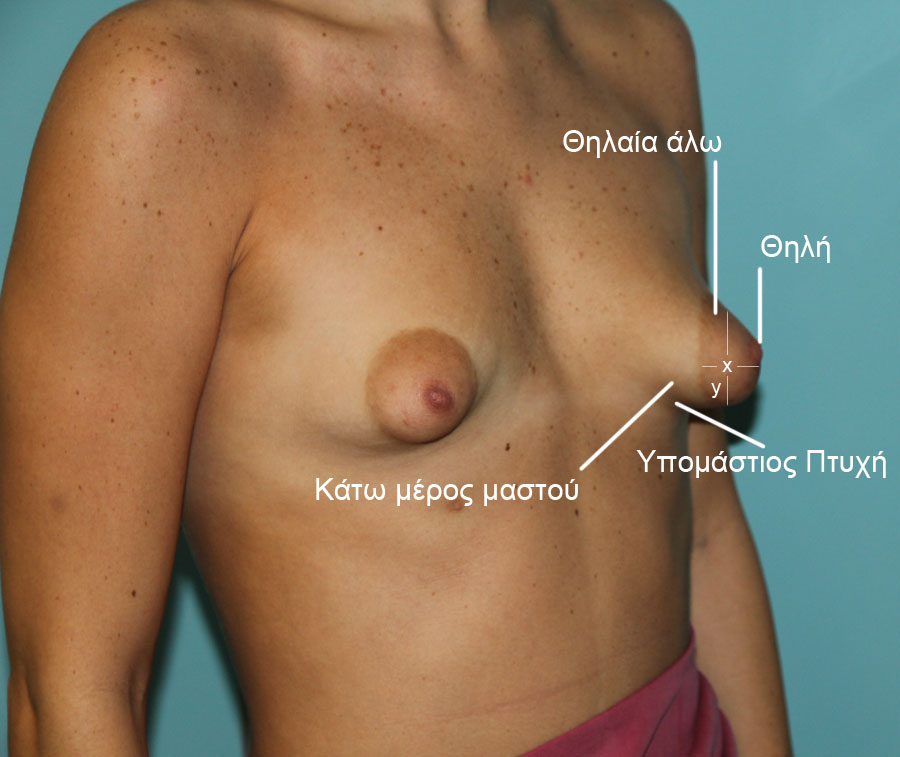
How is the areola corrected?
With a periareolar incision we reduce the areola to the desired size and manage breast projection. For closing we use a special technique and CV-3 suture.
Conclusion
Tuberous breasts can be easy to fix when the deformity is diagnosed before surgery and when all appropriate measures are taken to correct it. The new technique involves:
- Correction of the areola, where and when needed (ratio X/Y>0.35)
(ATTENTION, THIS IS NOT ALWAYS NECESSARY!)
- The Must technique in placing silicone implant for better expansion of the lower pole of the breast
Adhering to the above principles we may expect a very good result.
Wrong treatment of tuberous breast
Take a look at what can happen when a tuberous breast is not properly handled
What went wrong?
In the first case the breast develops an excessive "double bubble deformity" due to failure to correct the problem
https://www.keramidasevangelos.com/%CF%86%CF%89%CF%84%CE%BF%CE%B3%CF%81%CE%B1%CF%86%CE%AF%CE%B5%CF%82-%CF%80%CF%81%CE%B9%CE%BD-%CE%BC%CE%B5%CF%84%CE%AC/%CE%B1%CF%83%CF%8D%CE%BC%CE%BC%CE%B5%CF%84%CF%81%CE%BF-%CF%83%CF%84%CE%AE%CE%B8%CE%BF%CF%82/author/31-spyros?start=230#sigProId3bd2bc07d0
Effort to correct the areola diameter: if performed alone it fails to correct the deformity, and, if not performed correctly, it leads to further problems.
https://www.keramidasevangelos.com/%CF%86%CF%89%CF%84%CE%BF%CE%B3%CF%81%CE%B1%CF%86%CE%AF%CE%B5%CF%82-%CF%80%CF%81%CE%B9%CE%BD-%CE%BC%CE%B5%CF%84%CE%AC/%CE%B1%CF%83%CF%8D%CE%BC%CE%BC%CE%B5%CF%84%CF%81%CE%BF-%CF%83%CF%84%CE%AE%CE%B8%CE%BF%CF%82/author/31-spyros?start=230#sigProId7d1ae4e7d1
Take a look at the before and after pictures of tuberous breast surgeries
Challenging breast surgery cases
1) Capsular contracture
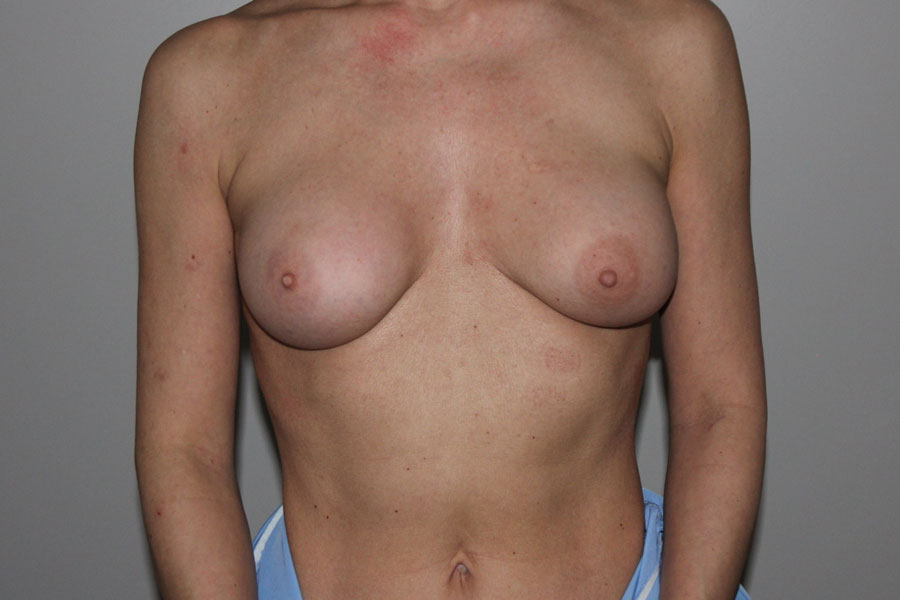
Α) A rare complication that may occur after breast augmentation.
We do not know its exact cause. The main hypothesis as to its cause and pathogenesis claims that this is a biological response to the implant (foreign body) leading to the formation of a capsular contracture around the implant. In capsular contracture, the reaction produces collagen fibres, fibroblasts and fibromyoblasts on the capsule. This becomes hard and is often painful.
Some factors such as subclinical inflammation, biofilm formation (bacteria on the implant surface), bleeding during surgery, incision location, implant pocket location, may increase the possibility of capsular contracture formation, however, there is no specific explanation as to its exact causes. Roughly, capsular contracture is classified in four Grades.
GRADE A : The patient does not feel anything but, during palpation, the doctor can identify tissue hardness.
GRADE B : Patient can feel a slight firmness of the breast.
GRADE C : The breast becomes firmer and starts to change in shape.
GRADE D : All above symptoms along with painful breast.
TREATMENT
The only treatment is surgical. 20 to 30 years ago, surgeons would try to break the capsule by pressing hard against the breast, but this technique is now strongly denounced.
EXAMPLE
Patient submitted to breast augmentation 5 years ago. She noticed that her left breast has started to change in shape and felt firmer. The patient’s implant was under the mammary gland.
SURGICAL APPROACH
1) Access through previous incision.
2) Implant removal.
3) Creation of new pocket beneath the pectoralis major muscle. (there are several indications suggesting that capsule formation is reduced when the implant is placed under the muscle.)
4) Use of rough surface implants (associated with less chances of capsular contraction.)
5) Suturing of the pocket.
6) Incision closure.
7) Result is full correction of the breasts.
8) How can we restrict capsular contracture:
- By placing the implant either under the muscle or by using the subfascial or dual plane technique
- Rough surface implants suggested most suitable
- Inframammary incision
- Non touch- No pain technique in surgery
- No bandages or tight bras or massage on the breasts after surgery
https://www.keramidasevangelos.com/%CF%86%CF%89%CF%84%CE%BF%CE%B3%CF%81%CE%B1%CF%86%CE%AF%CE%B5%CF%82-%CF%80%CF%81%CE%B9%CE%BD-%CE%BC%CE%B5%CF%84%CE%AC/%CE%B1%CF%83%CF%8D%CE%BC%CE%BC%CE%B5%CF%84%CF%81%CE%BF-%CF%83%CF%84%CE%AE%CE%B8%CE%BF%CF%82/author/31-spyros?start=230#sigProId40a76b6bd1
2) High-riding of implants
 Implants that are mispositioned higher than normal. Implants placed under the muscle can rarely be mispositioned higher up the chest.
Implants that are mispositioned higher than normal. Implants placed under the muscle can rarely be mispositioned higher up the chest.
Treatment
Example
Treatment is only surgical.
1) Planning of correct implant position.
2) Access through previous incision
3) Implant removal (no need to change the implant)
4) Preparation of down-facing pocket if needed
5) Implant placement
6) Suture
7) Results
https://www.keramidasevangelos.com/%CF%86%CF%89%CF%84%CE%BF%CE%B3%CF%81%CE%B1%CF%86%CE%AF%CE%B5%CF%82-%CF%80%CF%81%CE%B9%CE%BD-%CE%BC%CE%B5%CF%84%CE%AC/%CE%B1%CF%83%CF%8D%CE%BC%CE%BC%CE%B5%CF%84%CF%81%CE%BF-%CF%83%CF%84%CE%AE%CE%B8%CE%BF%CF%82/author/31-spyros?start=230#sigProId7929b02cf8
3) Tuberous Breast
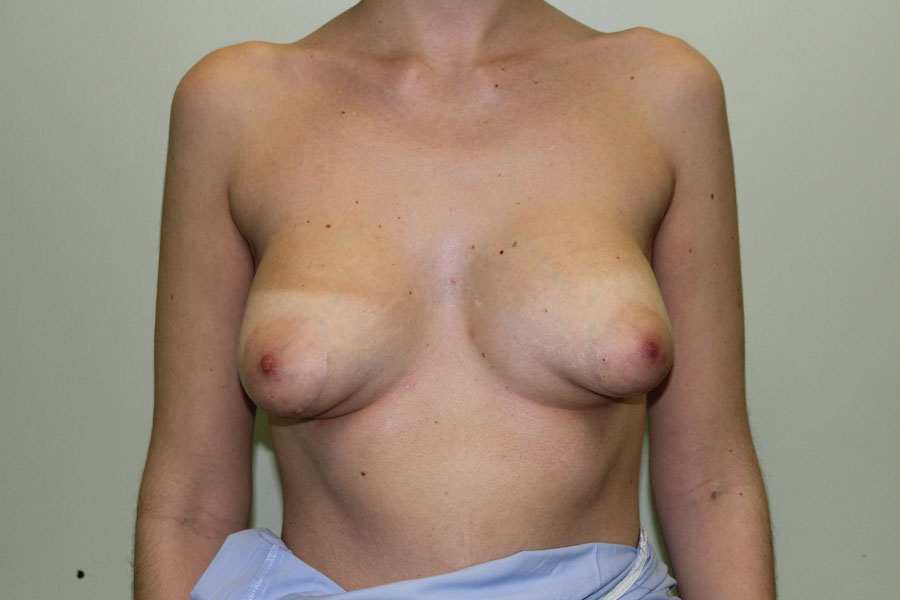
What is a tuberous breast?
The Tuberous or Tubular Breast is a congenital (birth) abnormality of the breast shape. There are several theories that try to explain how this condition occurs, but the exact cause is yet unknown.
Example
Patient submitted to breast augmentation.
Case: Patient with non-identified tuberous breast is seen with 1) double-bubble deformity 2) large areola 3) pocket deformity.
https://www.keramidasevangelos.com/%CF%86%CF%89%CF%84%CE%BF%CE%B3%CF%81%CE%B1%CF%86%CE%AF%CE%B5%CF%82-%CF%80%CF%81%CE%B9%CE%BD-%CE%BC%CE%B5%CF%84%CE%AC/%CE%B1%CF%83%CF%8D%CE%BC%CE%BC%CE%B5%CF%84%CF%81%CE%BF-%CF%83%CF%84%CE%AE%CE%B8%CE%BF%CF%82/author/31-spyros?start=230#sigProIdde7d87e362
Surgical approach
This is among the toughest cases we are called to treat
Surgery stages - diagnosis
Problems
1) Pocket
2) Lower quadrant of the breast
3) Areola
Surgical treatment
1) Incision around the areola – periareolar
2) Implant replacement
3) Pocket change from inframammary to M.U.S.T.
4) Release of entire breast
5) Vertical and horizontal lines to expand the inferior segment of the breast as this is a tuberous breast case

6) Placement of new implants
7) Lifting and correction of the areola with a special technique, the “tobacco pouch” and special permanent suture CV-3
8) Correction of right breast on the operating table
9) Left breast is not yet corrected
10) Same procedure is repeated for left breast
11) Correction of both breasts
12) First day post-op. Red-orange stain is Betadine
13) 6 months post-op
https://www.keramidasevangelos.com/%CF%86%CF%89%CF%84%CE%BF%CE%B3%CF%81%CE%B1%CF%86%CE%AF%CE%B5%CF%82-%CF%80%CF%81%CE%B9%CE%BD-%CE%BC%CE%B5%CF%84%CE%AC/%CE%B1%CF%83%CF%8D%CE%BC%CE%BC%CE%B5%CF%84%CF%81%CE%BF-%CF%83%CF%84%CE%AE%CE%B8%CE%BF%CF%82/author/31-spyros?start=230#sigProId864d9119e1
14) Results at 8 months post-op
https://www.keramidasevangelos.com/%CF%86%CF%89%CF%84%CE%BF%CE%B3%CF%81%CE%B1%CF%86%CE%AF%CE%B5%CF%82-%CF%80%CF%81%CE%B9%CE%BD-%CE%BC%CE%B5%CF%84%CE%AC/%CE%B1%CF%83%CF%8D%CE%BC%CE%BC%CE%B5%CF%84%CF%81%CE%BF-%CF%83%CF%84%CE%AE%CE%B8%CE%BF%CF%82/author/31-spyros?start=230#sigProId5d7dc7450f
15) Result comparison
https://www.keramidasevangelos.com/%CF%86%CF%89%CF%84%CE%BF%CE%B3%CF%81%CE%B1%CF%86%CE%AF%CE%B5%CF%82-%CF%80%CF%81%CE%B9%CE%BD-%CE%BC%CE%B5%CF%84%CE%AC/%CE%B1%CF%83%CF%8D%CE%BC%CE%BC%CE%B5%CF%84%CF%81%CE%BF-%CF%83%CF%84%CE%AE%CE%B8%CE%BF%CF%82/author/31-spyros?start=230#sigProId5d78bf38e8
Read more about tuberous breasts here
4) Double-bubble
 A rare complication seen following breast augmentation. Patients present with two parallel, transverse and curved folds along the lower pole of the breast that correspond to the breast and the silicon implant. Although the cause of this complication is yet to be clarified, surgeons believe that this is due to either a downward shifting of the implant, a capsular contraction or a ptosis of the breast. It is more often seen in cases of tuberous breasts, small breasts with disproportionately large implants, breasts with small areola to inframammary fold distance, breasts with large inframammary fold. There are several ways to correct this malformation. The most popular approach is capsulorraphy that allows the implant to shift to a normal position.
A rare complication seen following breast augmentation. Patients present with two parallel, transverse and curved folds along the lower pole of the breast that correspond to the breast and the silicon implant. Although the cause of this complication is yet to be clarified, surgeons believe that this is due to either a downward shifting of the implant, a capsular contraction or a ptosis of the breast. It is more often seen in cases of tuberous breasts, small breasts with disproportionately large implants, breasts with small areola to inframammary fold distance, breasts with large inframammary fold. There are several ways to correct this malformation. The most popular approach is capsulorraphy that allows the implant to shift to a normal position.
EXAMPLE
35-year-ole patient with double-bubble deformity following left breast augmentation.
TREATMENT
1) Planning of new implant position.
2) Access through previous incision.
3) Implant removal
4) Capsule suture with permanent internal stitches and restriction of previously enlarged area.
5) Result correction.
Another way to correct the double-bubble deformity is to create a new pocket between the pectoralis major and the anterior capsule. We then close the old pocket with stitches and place the implant in the new pocket.
3 Months after








 Send us your questions
Send us your questions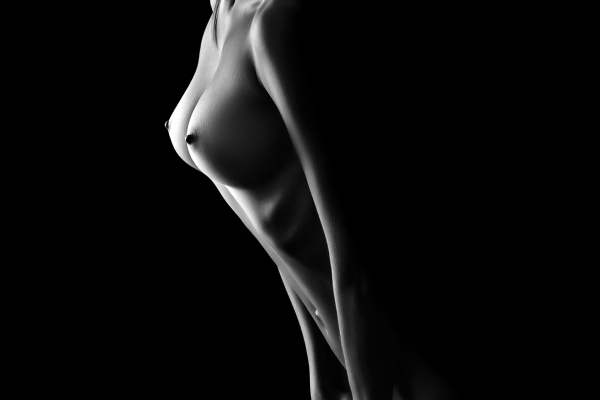



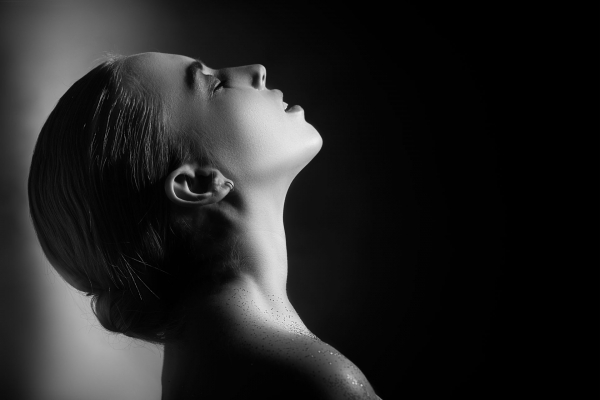


























Follow us

